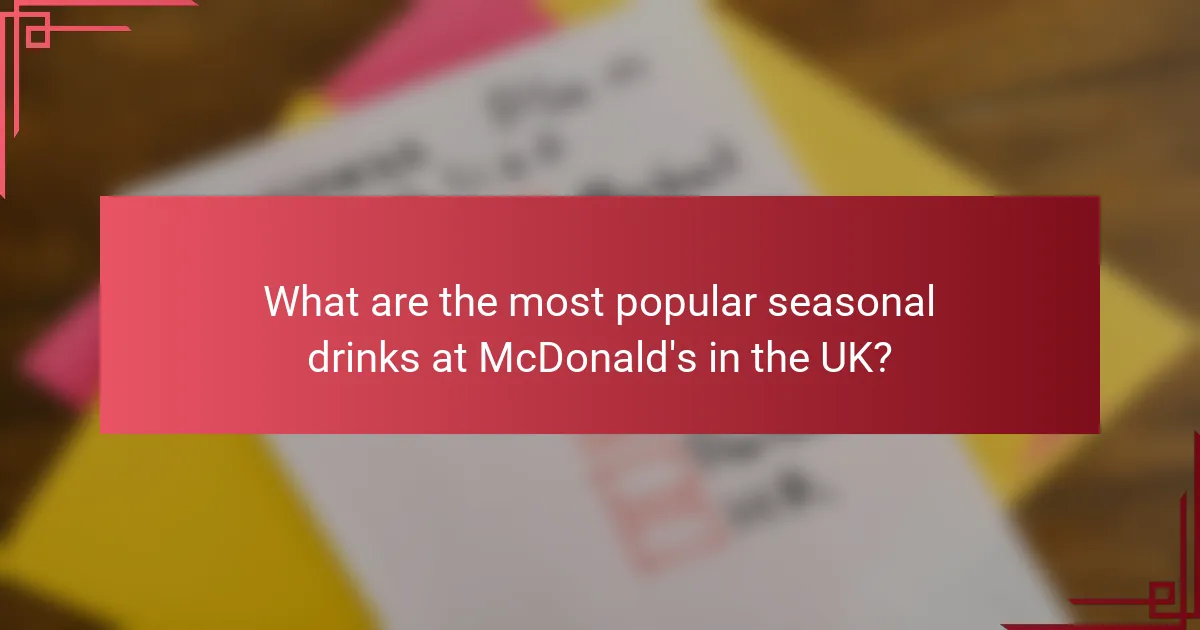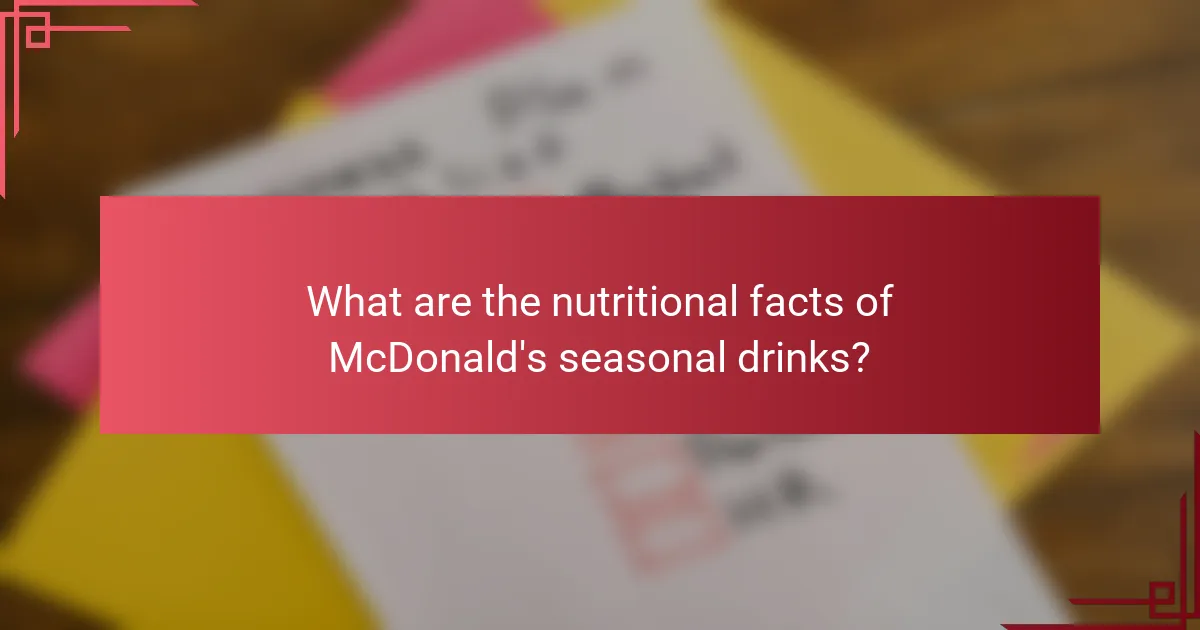McDonald’s seasonal drinks have become a beloved choice for customers in the UK, especially during festive times. With popular options like the Pumpkin Spice Latte and Mint Chocolate Chip Frappé, these beverages not only capture the essence of the season but also reflect current flavor trends that resonate with consumers.

What are the most popular seasonal drinks at McDonald’s in the UK?
In the UK, McDonald’s seasonal drinks are a favorite among customers, particularly during festive periods. Popular options include the McCafé Pumpkin Spice Latte, Strawberry Lemonade, and Mint Chocolate Chip Frappé, each offering unique flavors that align with seasonal trends.
McCafé Pumpkin Spice Latte
The McCafé Pumpkin Spice Latte is a seasonal classic that typically appears in autumn. This drink combines espresso with steamed milk, pumpkin puree, and a blend of spices, creating a warm and comforting flavor profile.
Available in various sizes, it often garners significant popularity, especially among those looking to embrace the fall season. Customers can customize their drink with options like whipped cream and extra spice for added indulgence.
McDonald’s Strawberry Lemonade
McDonald’s Strawberry Lemonade is a refreshing seasonal drink that is especially popular during the summer months. This beverage features a blend of lemonade and strawberry puree, resulting in a sweet and tangy flavor that is perfect for warm weather.
It is typically served chilled, making it an ideal choice for those seeking a cool refreshment. Customers appreciate its vibrant color and fruity taste, which can be enjoyed on its own or paired with a meal.
McCafé Mint Chocolate Chip Frappé
The McCafé Mint Chocolate Chip Frappé is a seasonal favorite that often appears around the winter holidays. This drink combines a creamy base with mint flavor and chocolate chips, delivering a festive and indulgent experience.
Served cold, it is a popular choice for those looking to treat themselves during the holiday season. The combination of mint and chocolate appeals to many, making it a sought-after option for both children and adults alike.

When are seasonal drinks available at McDonald’s in the UK?
Seasonal drinks at McDonald’s in the UK are typically available during specific times of the year, primarily in autumn and winter. These offerings often coincide with festive occasions and popular flavors that resonate with the season.
Available during autumn and winter
During autumn and winter, McDonald’s introduces a variety of seasonal drinks that reflect the flavors of the season. Popular options include spiced lattes, hot chocolates, and festive smoothies, which are available from late September through early January.
These drinks are often crafted with seasonal ingredients like pumpkin spice or peppermint, appealing to customers looking for warm, comforting beverages. Availability may vary by location, so checking with your local McDonald’s is advisable.
Limited-time offers during holidays
McDonald’s also features limited-time offers for seasonal drinks during key holidays such as Christmas and Halloween. These drinks are typically promoted as special editions and may include unique flavor combinations or festive packaging.
For instance, around Christmas, you might find drinks like the Gingerbread Latte or a special edition of Eggnog Shake. These offerings are usually available for a few weeks, so it’s best to enjoy them while they last.

How do flavor trends influence McDonald’s seasonal drinks?
Flavor trends significantly shape McDonald’s seasonal drinks by guiding the introduction of new flavors and the popularity of existing ones. Seasonal offerings often reflect current consumer preferences, which can lead to increased sales and customer satisfaction.
Emerging flavors like salted caramel
Salted caramel has gained traction as a popular flavor in various food and beverage categories, including seasonal drinks at McDonald’s. This flavor combines sweetness with a hint of salt, appealing to consumers looking for a more complex taste experience.
McDonald’s has successfully incorporated salted caramel into its seasonal offerings, often during fall and winter. This trend not only attracts customers but also encourages them to try new combinations, enhancing their overall experience.
Consumer preference for fruity options
Fruity flavors are increasingly favored by consumers, especially during warmer months. McDonald’s seasonal drinks often feature fruit-based options like strawberry, mango, or tropical blends, catering to this demand.
These fruity drinks are refreshing and often perceived as healthier alternatives to traditional sugary beverages. By offering a variety of fruity flavors, McDonald’s can appeal to a broader audience, including those seeking lighter options during the summer season.

What are the criteria for selecting seasonal drinks at McDonald’s?
McDonald’s selects seasonal drinks based on consumer preferences, ingredient availability, and market trends. These criteria ensure that the offerings resonate with customers while utilizing fresh, in-season ingredients.
Market research on consumer preferences
Market research plays a crucial role in determining which seasonal drinks McDonald’s introduces. Surveys and focus groups help identify popular flavors and trends among customers, allowing the company to tailor its offerings to meet consumer demand.
For example, during the fall, pumpkin spice flavors often gain traction, while summer might see a rise in fruity, refreshing options. Understanding these preferences helps McDonald’s create drinks that attract more customers.
Seasonal ingredient availability
The availability of seasonal ingredients significantly influences the selection of drinks at McDonald’s. The company aims to use fresh, locally sourced ingredients when possible, which enhances flavor and supports local economies.
For instance, summer drinks may feature berries or citrus fruits that are in season, while winter offerings might include spices or flavors associated with colder months. This approach not only ensures quality but also aligns with customer expectations for seasonal products.

How does McDonald’s promote seasonal drinks in the UK?
McDonald’s promotes seasonal drinks in the UK through targeted marketing strategies that engage customers both online and in-store. These efforts aim to create excitement and drive sales during specific times of the year, aligning with seasonal themes and flavors.
Social media marketing campaigns
McDonald’s utilizes social media platforms like Facebook, Instagram, and Twitter to showcase its seasonal drinks. These campaigns often feature eye-catching visuals and engaging content that highlight new flavors and limited-time offers, encouraging customers to share their experiences.
Hashtags and challenges are common tactics, allowing fans to participate and spread the word. For example, a seasonal drink might be promoted with a unique hashtag, inviting customers to post their favorite ways to enjoy it, which can significantly boost visibility.
In-store promotions and signage
In-store promotions play a crucial role in McDonald’s strategy for seasonal drinks. Eye-catching signage near the counter and in the dining area draws attention to new beverages, often featuring vibrant images and enticing descriptions to attract customers.
Additionally, promotional materials such as flyers and posters can highlight special deals or combo offers that include seasonal drinks, making it easier for customers to choose these options. Seasonal flavors are often prominently displayed on menus to ensure they are top of mind during the promotional period.

What are the nutritional facts of McDonald’s seasonal drinks?
McDonald’s seasonal drinks vary widely in their nutritional content, particularly in calories and sugar levels. Understanding these facts can help customers make informed choices based on their dietary preferences and health goals.
Caloric content of Pumpkin Spice Latte
The Pumpkin Spice Latte is a popular seasonal offering that typically contains around 300 to 500 calories, depending on the size and any customizations like whipped cream or additional syrup. The calorie count can significantly increase with added toppings or larger sizes.
For those watching their caloric intake, opting for a smaller size or requesting fewer pumps of syrup can help reduce the overall calorie content. It’s advisable to check McDonald’s official nutritional information for the most accurate details.
Sugar levels in Strawberry Lemonade
Strawberry Lemonade from McDonald’s generally contains a high sugar content, often ranging from 30 to 60 grams per serving. This sugar level can contribute significantly to daily intake, especially for those monitoring their sugar consumption.
To mitigate sugar intake, consider ordering a smaller size or asking for less syrup. Being aware of the sugar content in seasonal drinks can aid in making healthier choices while enjoying these refreshing beverages.

What are customer reviews of McDonald’s seasonal drinks?
Customer reviews of McDonald’s seasonal drinks often highlight their unique flavors and limited-time availability. Many patrons appreciate the novelty and festive themes, while some express disappointment when their favorites are not available year-round.
General Sentiment
The general sentiment towards McDonald’s seasonal drinks tends to be positive, with many customers enjoying the creativity behind flavors like Pumpkin Spice or Peppermint Mocha. These drinks often evoke nostalgia and seasonal cheer, making them popular choices during holidays.
Flavor Preferences
Flavor preferences vary widely among customers, with some favoring classic options like Eggnog Latte, while others lean towards more adventurous flavors such as Caramel Brulee. Seasonal offerings often reflect current trends, appealing to a broad audience.
Availability Issues
Availability can be a significant issue, as seasonal drinks are typically offered for a limited time. Customers frequently express frustration when their favorite drinks sell out quickly or are not available at all locations. It’s advisable to check local menus or app listings for the most accurate availability.
